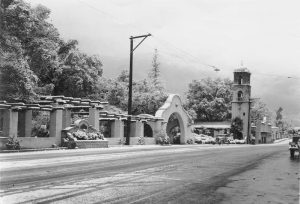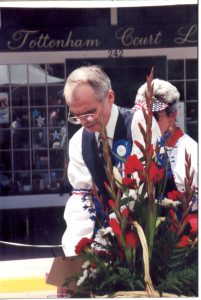This article first appeared in the Ojai Valley News on February 19, 1999. It is used here with their permission.
Evelyn Nordhoff is Returned
By
David Mason
“The People of The Ojai can best show their appreciation of the generosity of the donors by keeping the fountain free from defacements, and by gradually developing around it village improvements of other kinds.” –The Ojai, Saturday, October 15, 1904
The journey to the town of Nordhoff, now Ojai, was long and tiring.
The dusty road was hardly passable in many places and the fact that the buggies had to ford rivers at least a dozen times didn’t help. The wild berries hanging down from the low tree limbs seemed to cover the trail.
There was a sign of relief when the buggies made it to the small camping area, now Camp Comfort, to take a rest. The stream was always running with cool water and the towering trees provided a shady nook.
When travelers finally reached the small western town of Nordhoff, the first stop was the conveniently placed watering trough and drinking fountain in the center of town.
The fountain was a beautiful addition to the small community which had earlier lacked any architectural charm – it’s design would eventually become known as “Mission Revival” and it was one of the earliest examples.
The Ventura Free Press called it “one of the finest fountains in the state,” and described it in detail.
“On the side facing the middle of main street, we see the drinking place for horses, consisting of a stone trough about twelve feet long, two feet deep and two feet wide, always full of running water supplied from a pipe running out of the lion’s mouth.
“A division, the centerpiece of the fountain, runs lengthwise directly back of the horse trough, and is made prettier by having the stone cut into mouldings at either end. This piece is about fourteen feet long and fully eight feet high in the middle, and is rounding at the top. At each end of this, only a few inches above the ground, the poor thirsty dogs find drinking places.
“The drinking place for humanity is found on the side next to the Ojai Inn, and consists of a large bowl hollowed out of a piece of stone, into which runs a tiny stream of water from a small lion’s mouth.
“The donor has not forgotten the tired traveler, but has built a broad resting place for him on a big slab of stone. The Ojai newspaper refers to as ‘an ornament we should be proud of.'”



The fountain, built in memory of Evelyn Hunter Nordhoff in 1904, was indeed an improvement to the downtown block. The community of Nordhoff, the principal settlement in the Ojai Valley, had been established in 1874 and was still in its early stages of development. Evelyn Nordhoff was the daughter of Charles Nordhoff, the well-known author for whom the town was named.
Evelyn Nordhoff’s early life was spent at the family home on the New Jersey palisades, in an area which would eventually become known as “Millionaire’s Row.”
As a young woman, Evelyn enrolled at Smith College, located in west-central Massachusetts and founded in 1871 for the education of women. Her schooling was cut short after one year, with the reason given that “she was needed at home.”
Evelyn learned to etch copper and gained notice by producing decorative, printed calendars. She also created artistically-worked leather pieces.
According to researcher Richard Hoye, “An opportunity opened for Evelyn to visit England when her brother Walter was posted there as a newspaper correspondent.”
In 1888, the first Arts and Crafts exhibition was staged in London, and a co-founder of the exhibition society, Thomas Cobden-Sanderson, presented four lectures on bookbinding. Evelyn’s attendance at these lectures piqued her interest in that line of work.
When she eventually returned to America, the Nordhoff family made a touring visit to California. The Ventura County newspaper reported that the Nordhoffs passed through the seaside town and went directly to the Ojai Valley.
Returning to New York City, Evelyn obtained work with a bindery to pursue her interest in the art of bookbinding. There she learned to sew pages and to mend old books. This was the first level of the craft. Evelyn would learn the business from many teachers before she became proficient in the skill of bookbinding.
Evelyn opened her own workroom in Greenwich Village across from the New York University. Her artistry in the work of bookbinding began to gain attention for the young Evelyn as a woman and an artist. She possessed the Nordhoff sense of independence, and the initiative in pursing against the odds.
Training in a craft from which women had previously been excluded reflects a high degree of personal determination and she was a good example of a confident and talented woman, the first woman in the United States to take up the vocation of artistic bookbinding.
Evelyn Nordhoff spent her summer months in California with her parents, who, by this time, made their home in Coronado. In late summer of 1889, when Evelyn would again have departed from Coronado after a summer’s visit, her parents did not realize that this would be their last parting with their daughter, for in November they received word she had died.
She had suffered an attack of appendicitis, was operated on, and failed to recover.
The Nordhoff fountain was given to the community of Nordhoff by sisters Olivia and Caroline Stokes in Evelyn’s memory. The Stokes sisters had inherited wealth from banking, real estate and other interests in the New York City area. They were lifetime companions, never married, especially devout and well-known philanthropists. Their gifts were numerous and worldwide.
The Stokes sisters visited the Ojai Valley in 1903, staying at the Hughes home on Thacher Road, and were probably influenced by Sherman Thacher, founder of a nearby boys’ school, to build the fountain as a lasting memorial to this talented young lady.
Richard Hoye suggests that, “There may also have been a temperance motive. The banning of liquor was strongly supported in the community and by the Stokes sisters. A drinking fountain closely located to a horse trough would remove an excuse that stage drivers and their passengers might have had to resort to alcohol to slacken their thirst after a dusty trip from Ventura to the mountain town.”
In 1917, when Edward D. Libbey, Ojai’s greatest benefactor, began his transformation of the small town, he had the fountain moved back four feet to widen the roadway.
Libbey removed the Ojai Inn and built a beautiful, wisteria-covered, arched and walled pergola. With the fountain as the center focal point, an attractive entrance was created into the Civic Center Park, now Libbey Park.


In the 1960s, the whole structure began to shown signs of age and suffered major damage from vandalism. In the turmoil of this period, the entrance arch was damaged by explosives and by 1971 the pergola and fountain were removed.

The bronze plaque on the fountain that was inscribed, “In memory of Evelyn Hunter Nordhoff, this fountain is given to the people of Nordhoff, 1904” was returned to members of the Nordhoff family.
With the restoration of this landmark – the pergola and the Nordhoff fountain – the bronze plaque has been returned to the people of the Ojai Valley. The plaque will once again be placed on this beautiful fountain which will be rebuilt in memory of Evelyn’s aspirations and accomplishments – a spirit which has prevailed in the history of the Ojai Valley, in its schools and its artistic culture.



This article is beautiful and should be read and appreciated by everyone.